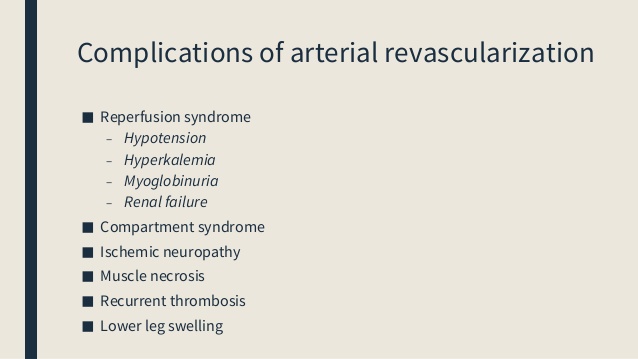Reperfusion injury natural history: Difference between revisions
Jump to navigation
Jump to search
No edit summary |
No edit summary |
||
| Line 3: | Line 3: | ||
[[File:IRI Complications.jpg|thumb|342x342px|Complications of IRI]][[Myocardial stunning]]: Delayed recovery, usually 2-3 days, of the viable [[myocardium]] after [[reperfusion]] is termed as "[[Stunned myocardium|myocardial stunning]]". It is mainly due to the release of [[reactive oxygen]] species and [[intracellular]] [[calcium]] overload. | [[File:IRI Complications.jpg|thumb|342x342px|Complications of IRI]][[Myocardial stunning]]: Delayed recovery, usually 2-3 days, of the viable [[myocardium]] after [[reperfusion]] is termed as "[[Stunned myocardium|myocardial stunning]]". It is mainly due to the release of [[reactive oxygen]] species and [[intracellular]] [[calcium]] overload. | ||
* [[Myocardial infarction]]: [[Irreversibility|Irreversible]] myocyte cell death secondary to reduced [[oxygen]] delivery for more than 20-30 minutes, will lead to [[infarction]]. [[Reperfusion]] helps prevent complete loss of the involved area, however [[oxidative stress]] due to this may prevent complete resolution. | * [[Myocardial infarction]]: [[Irreversibility|Irreversible]] myocyte cell death secondary to reduced [[oxygen]] delivery for more than 20-30 minutes, will lead to [[infarction]]. [[Reperfusion]] helps prevent complete loss of the involved area, however [[oxidative stress]] due to this may prevent complete resolution<ref name="urlimage.slidesharecdn.com">{{cite web |url=https://image.slidesharecdn.com/acutelimbischemia-180511172855/95/acute-limb-ischemia-51-638.jpg?cb=1526059810 |title=image.slidesharecdn.com |format= |work= |accessdate=}}</ref>. | ||
* Acute [[heart failure]]: Loss of [[myocardial]] [[contractility]] and [[systolic]] dysfunction associated with [[ischemia]]/reperfusion injury may lead to the development of [[acute heart failure]]. Early [[reperfusion]] in the course of [[STEMI]] prevents [[myocardial]] [[necrosis]] and may lead to complete recovery of function. | * Acute [[heart failure]]: Loss of [[myocardial]] [[contractility]] and [[systolic]] dysfunction associated with [[ischemia]]/reperfusion injury may lead to the development of [[acute heart failure]]. Early [[reperfusion]] in the course of [[STEMI]] prevents [[myocardial]] [[necrosis]] and may lead to complete recovery of function. | ||
* [[Ventricular arrhythmia]]s: [[Reperfusion]] of the blocked [[coronary artery]] can also precipitate [[arrhythmias]] ranging from [[ventricular premature beat]]s to life-threatening [[ventricular fibrillation]]. | * [[Ventricular arrhythmia]]s: [[Reperfusion]] of the blocked [[coronary artery]] can also precipitate [[arrhythmias]] ranging from [[ventricular premature beat]]s to life-threatening [[ventricular fibrillation]]. | ||
Revision as of 19:00, 16 August 2020
Editors-In-Chief: Anjan K. Chakrabarti, M.D. [1]; C. Michael Gibson, M.S., M.D. [2]; Dr. Shivam Singla M.D. [2] Associate Editors-In-Chief: Kashish Goel, M.D ;
Complications

Myocardial stunning: Delayed recovery, usually 2-3 days, of the viable myocardium after reperfusion is termed as "myocardial stunning". It is mainly due to the release of reactive oxygen species and intracellular calcium overload.
- Myocardial infarction: Irreversible myocyte cell death secondary to reduced oxygen delivery for more than 20-30 minutes, will lead to infarction. Reperfusion helps prevent complete loss of the involved area, however oxidative stress due to this may prevent complete resolution[1].
- Acute heart failure: Loss of myocardial contractility and systolic dysfunction associated with ischemia/reperfusion injury may lead to the development of acute heart failure. Early reperfusion in the course of STEMI prevents myocardial necrosis and may lead to complete recovery of function.
- Ventricular arrhythmias: Reperfusion of the blocked coronary artery can also precipitate arrhythmias ranging from ventricular premature beats to life-threatening ventricular fibrillation.
Prognosis
Prognosis in CNS patients
- Those patients who are identified and treated early, the prognosis is better along with the decreased incidence of intracranial hemorrhage. Outcomes usually depend on the timely recognition and prevention of precipitating factors. Hypertension management is most important before it can inflict damage in the form of edema or hemorrhage
- The prognosis following hemorrhagic transformation is poor. Mortality in such cases is 3663%, and 80% of survivors have significant morbidity.
- Studies indicate that reperfusion injury is involved directly in the potentiation of stroke damage. Components of the inflammatory response, including cytokine release and leukocyte adhesion, appear to play key roles in these deleterious effects.
Prognosis in CVS patients
- Reperfusion injury contributes to up to 50% of the total myocardial damage. In spite of many successful results in animals, the translation into the clinical setting has been disappointing for many years.